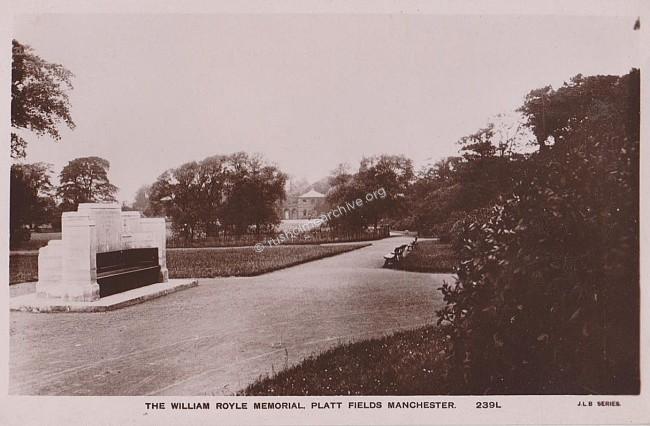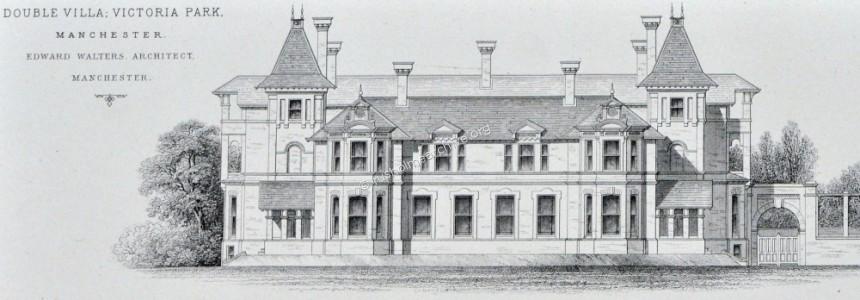Rusholme & Victoria Park Archive
Welcome to the Rusholme Archive
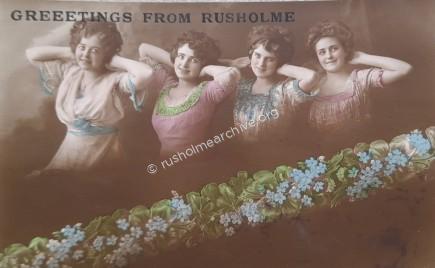
'Look at the place to-day with its rushing tram cars, crowded foot-paths, cafes, billiard halls, theatres, and the people spending most of their time in the streets or in places of amusement.' William Royle, November 24th, 1912
In the photograph below, circa 1907-09, are these the rushing tramcars, crowded footpaths, cafes that William Royle was so concerned about?
The photograph has been taken on the corner of Wilmslow Rd and the junction of Dickenson Rd, (looking north to Manchester).
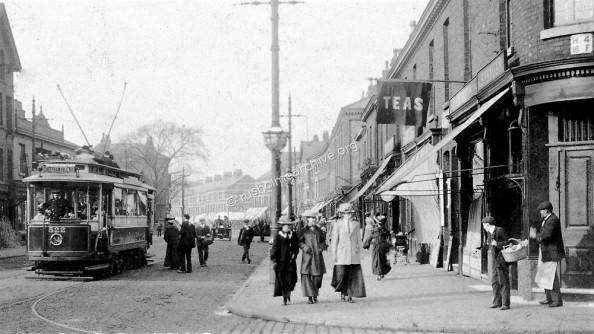
This opening page of rusholmearchive is just a quick 'tasting menu' of what you can find on this website - just look at the menu on the left to find various stories that explore different aspects of Rusholme, Victoria Park and Fallowfield
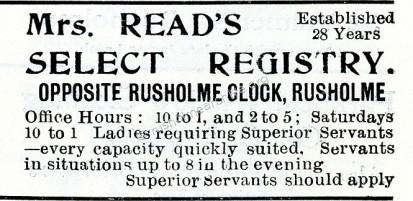
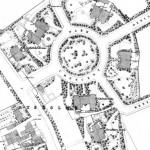 The photograph below is the entrance into Victoria Park from the northerly end of Wilmslow Road and if you were to enter the gates here you came into Park Crescent. The houses built around the Crescent were designed by Richard Lane, the notable Manchester architect who was one of the principal members of the company responsible for promoting Victoria Park.
The photograph below is the entrance into Victoria Park from the northerly end of Wilmslow Road and if you were to enter the gates here you came into Park Crescent. The houses built around the Crescent were designed by Richard Lane, the notable Manchester architect who was one of the principal members of the company responsible for promoting Victoria Park.
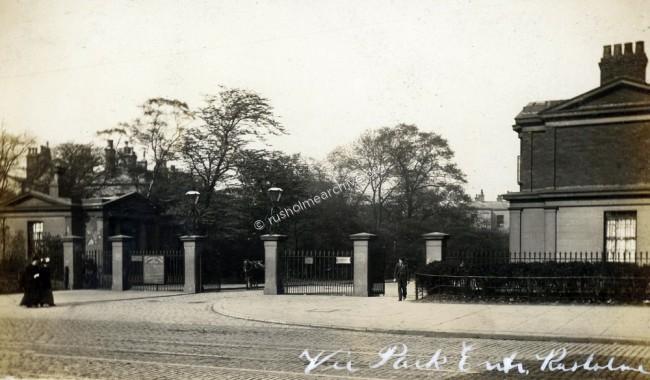
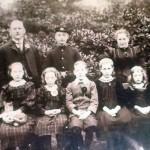 When the two lodges were built in 1837, they were both single storey, however, in 1893/94 the right-hand lodge had an additional floor added, presumably to accommodate a family. Certainly from 1887 Henry Devey, a former London policeman was living here as the gatekeeper. The photograph (click on the inset) is of Henry, his wife and children who somehow were accommodated in the four rooms. The postcard view (above), was probably taken circa 1905, by 1908 the lodges had been demolished and replaced by shops. The gates remained until 1918 when they were moved further back towards the Crescent, the park finally being opened to the public in 1954.
When the two lodges were built in 1837, they were both single storey, however, in 1893/94 the right-hand lodge had an additional floor added, presumably to accommodate a family. Certainly from 1887 Henry Devey, a former London policeman was living here as the gatekeeper. The photograph (click on the inset) is of Henry, his wife and children who somehow were accommodated in the four rooms. The postcard view (above), was probably taken circa 1905, by 1908 the lodges had been demolished and replaced by shops. The gates remained until 1918 when they were moved further back towards the Crescent, the park finally being opened to the public in 1954.
Below is another photograph of the Oxford Road entrance to Victoria Park, in colour it is dated 1909, you can read more about the history and homes in the Park from the menu on the left, there are four consecutive pages beginning with ‘Victoria Park’.
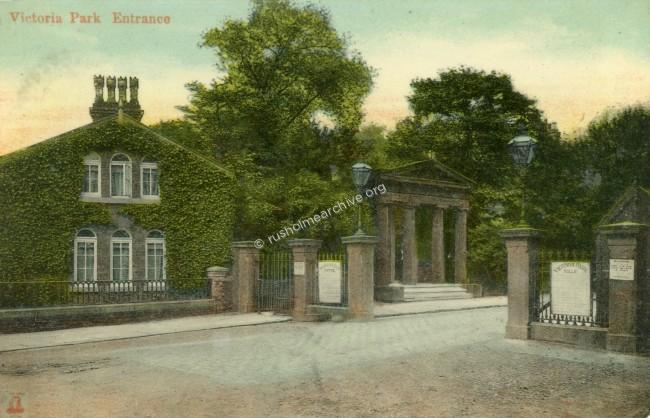
Postcard view below of Wilmslow Rd and junction of Dickenson Rd, (looking north to Manchester is dated Sept 1904. Most notably the tram is a single decker for this particular route, Brooks Bar to Belle Vue.
Read more about the tramcars and a detailed description of the photographs on the page, 'A Tour of Wilmslow Rd'.
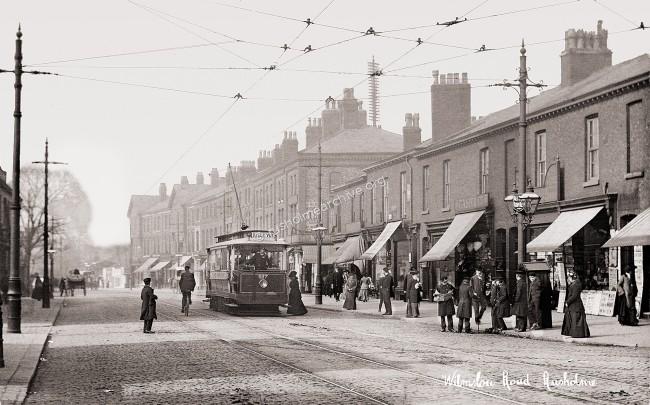
Photograph below, looking south and dated 1906. A similar viewpoint from the above photograph and a marvelous view of the Birch Villa Hotel. The photograph is not in the best of condition, however the action is very animated!
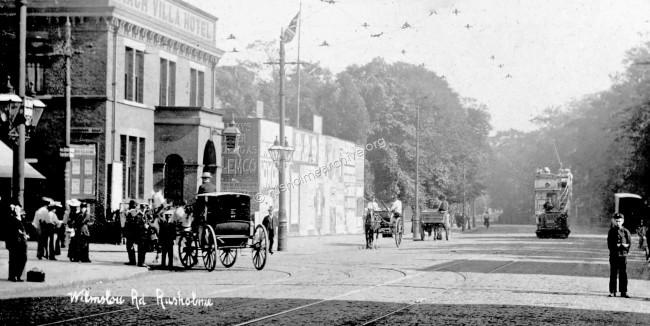
In the image above you can see a large poster hoarding to the right of the Birch Villa Hotel.
Behind the poster hoardings was Harry Leslie's 'Rusholme Pavilion' where for some 40 years there were very popular concerts. The large poster below was for a show in May 5th 1914. See the menu on the left for Harry Leslie and the Rusholme Pavilion.
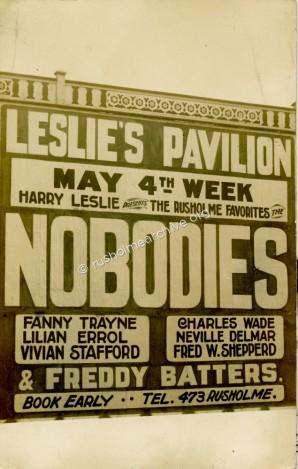
Haymaking, Platt Fields 1907
In 1907 there were considerable efforts being made for Platt Hall and the surrounding estate to be acquired by Manchester City Council as a public park. William Royle, a notable Rusholme resident successfully led the campaign, on the back of the photograph below he has written a note, 'Memento of s successful agitation, 1907'. You can read more about Platt Hall and Platt Fields, see the menu left.
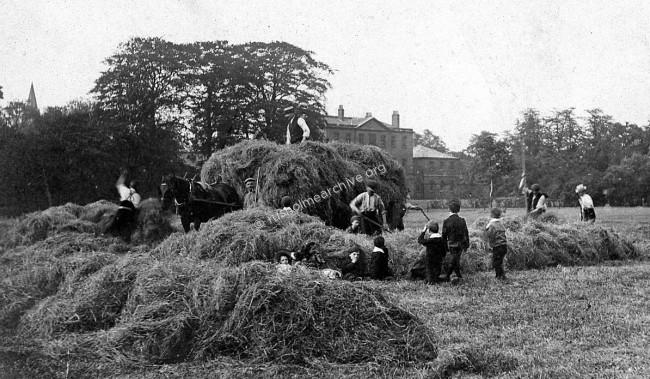
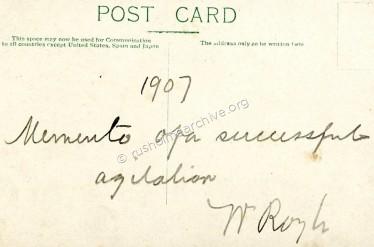
Fallowfield Brow, often referred to as 'The Boulevard' was always popular, photographed with residents leisurely spending time under cover of the majestic trees as carriages, trams, bicycles and carts passed by.
Here in this undated photograph below, perhaps from the 1920's, a soldier on horseback is riding in a northerly direction.
Look at the menu on the left for Fallowfield Brow and Oak Drive.
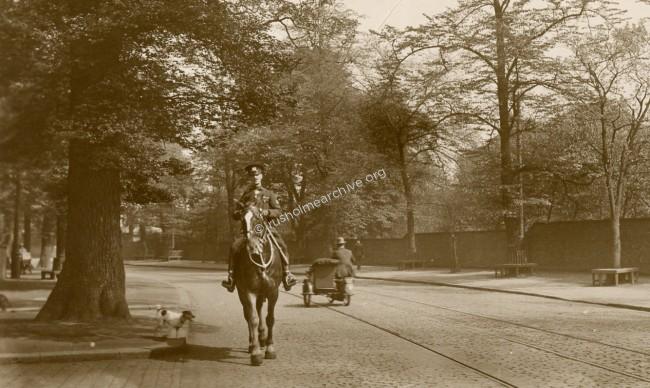
Another view below of Fallowfield Brow but in this case it is the message on the reverse that is so poignant, almost brutal.
Remember that postcard views, (which are the principal means of illustrating rusholmearchive), were the cheapest and perhaps the quickest means of communication a century ago - guaranteed overnight delivery, or if local probably the same day on the second delivery! Postcards were the equivalent of our email and texting!.
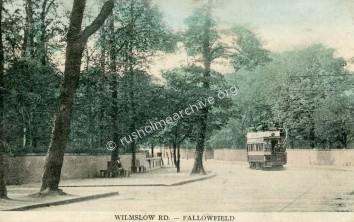
The message is simple;
"Dear Polly,
Do not get me anything as I am going to my sister her baby is dead,
From Clara"
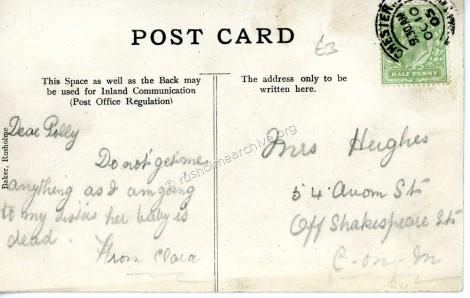
In July 1905 there was a visit to Manchester by King Edward VII and Queen Alexandra. It was proposed that the occasion should be marked with the declaration of the day as a Bank Holiday. Harry Leslie decorated his canvas Pavilion with a variety of flags to celebrate the special occasion on July 13th as you can see in the card below.
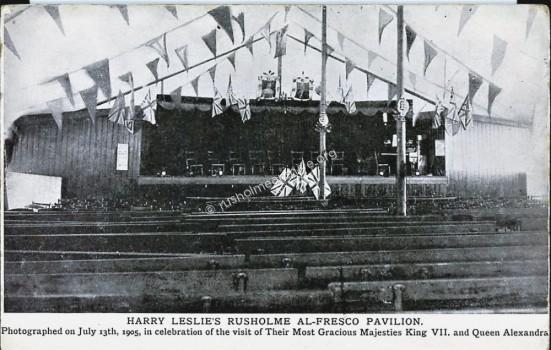
Rusholme residents were able to listen to bands playing in all three parks, Birch Park, Platt Fields and Whitworth Park. The Manchester Professional Military Band in the photograph below were billed to play in all three parks. To date I have not been able to find whether the band members had any military background.
Searching Manchester newspapers I have found that the band appeared to have started some time in the 1890's and continued playing until the 1930's. If anyone has more information I would be pleased to hear from them.
You can see more about each park and see the bandstands in each of the parks by looking at the menu on the left.
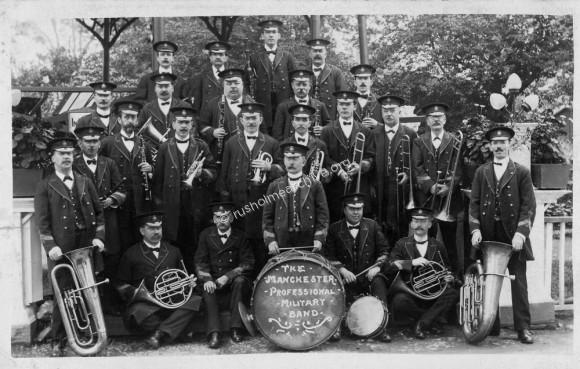
The Manchester Guardian reported that on Saturday 18th July 1914, deprived children from the poorest parts of Manchester had a day out in the park, having been given two pieces of cake, a bun, half a slice of bread and butter, and tea or milk.

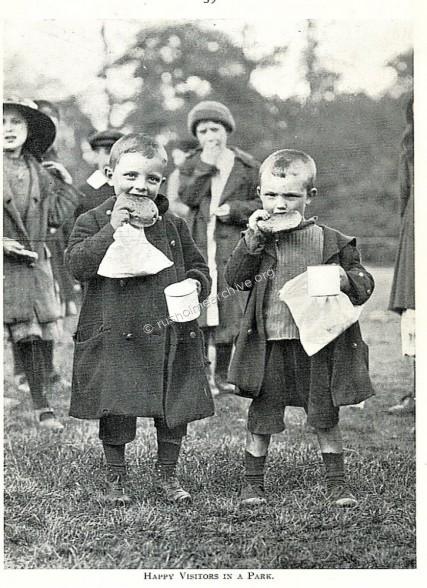
"Nearly two thousand poor children were taken from Ancoats to Platt Fields by tram yesterday, and spent a pleasant afternoon there notwithstanding the wet weather. It was the first of a series of trips that has been organised by the Education Committee, the Parks Committee, the Tramways Committee, and the readers of the Manchester Evening News. Twice a week from now till the middle of August these parties will be given in one or other of the parks until the children of Gorton, Bradford and Clayton, Ardwick, Miles Platting and Newton Heath, Collyhurst and Red Bank, Deansgate and Lower Hulme, and Upper Hulme and Chorlton-on-Medlock have all had their turn.
The Ancoats boys and girls assembled in Birley Street Council School yard, and were put into the cars very quickly. Within half an hour the twenty-one cars that had been lent by the Tramways Committee were all full and moving off on their journey, and the children were disembarked quite as expeditiously. They reached Platt Fields at three o’clock, while it was raining, but they soon found shelter, either at the boathouse, where they were at once attended by a ventriloquist, or within the big Georgian Hall. There or thereabouts they stayed till the sun came out, consuming the provisions that had been furnished out of the “Manchester Evening News ” fund — two pieces of cake, a bun, half a slice of bread and butter, and tea or milk.
Presently the sun began to shine, the band to play, and the children to come out, and at once the grass in front of the hall was covered with empty paper bags. The park-keepers, to their credit, were a good deal more amused than annoyed by it. Wickets were set up here and there, but the greatest crowd was at the lake, where there was a long, long queue outside the railings waiting for the chance of a journey round the island. From that time forward it was fine till half-past seven, when the tramcars ranged themselves once more outside the park, which emptied suddenly of it’s tumultuous juvenile population."
You can see more children playing in the in the parks on the menu, 'A very Popular Park,' or 'A Gentle Stroll around the Park'.
In the photograph below the Royal Coach used by the King and Queen for a visit to Manchester in 1905. The coach was stored in the Rusholme stables, referred to in a 'Tour of Wilmslow Road'. There was another Royal visit on Monday 13th July 1913, see the menu on the left.
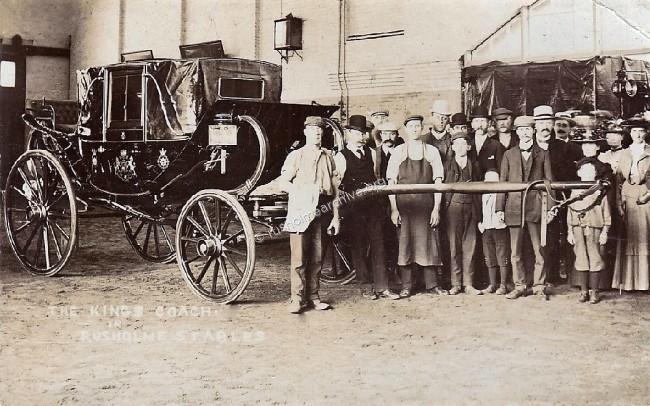
Also on the page 'A Tour of Wilmslow Road' you can get a glimpse of the western end of Dickenson Road, below is a photograph of Frank Hotchin, Butcher, 66 Dickenson Road.
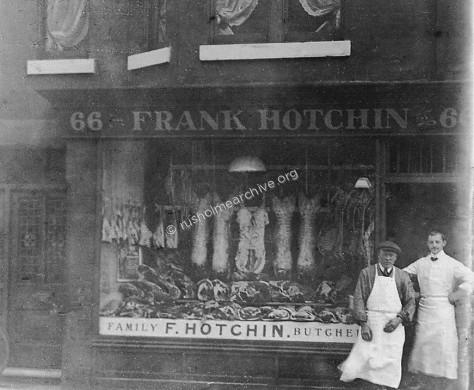
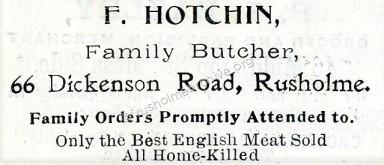
4th Volunteer Battalion, Manchester Regiment
The photograph below was probably taken in April 1905. The soldiers marching, (and rather blurred!) were probably returning to their barracks. The following notice appeared in the press;
"The 4th Volunteer Battalion of the Manchester Regiment was exercised on Saturday afternoon, being drilled in Platt Fields. Lieutenant Colonel J. B. Pollitt had a record parade, about 650 of all ranks being in uniform. The Service dress was worn, for the first time on a Manchester parade, and the strength of the corps on this occasion can be taken as evidence of the growing popularity of this uniform. A big crowd accompanied the battalion to Platt Fields and watched the close-order movements of the larger body and the work of the signaling detachment.
The street that can be seen on the left is Thurloe Street, there is a butchers shop on the corner called 'J Lockwood', the shop with the big sign, 'Bentons' I believe to have been a tobacconist.
Whilst this photograph is not of the best technical quality it is certainly very animated.
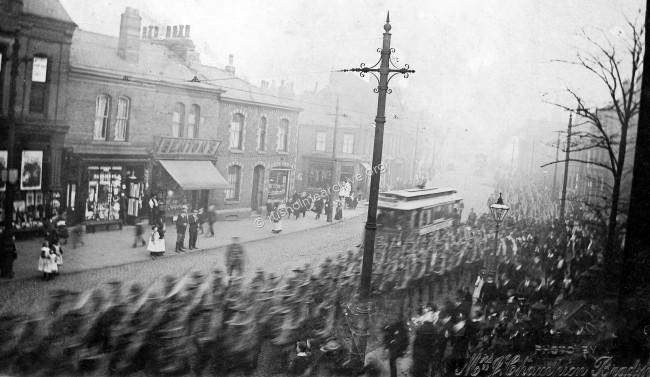
World War 1 Memories
The photograph below is of Lydia Kayasht, (centre), a famous Russian dancer. It was taken at the Elizabeth Gaskell School of Domestic Economy in September 1915 when the premises were being used as a hospital during WW1.
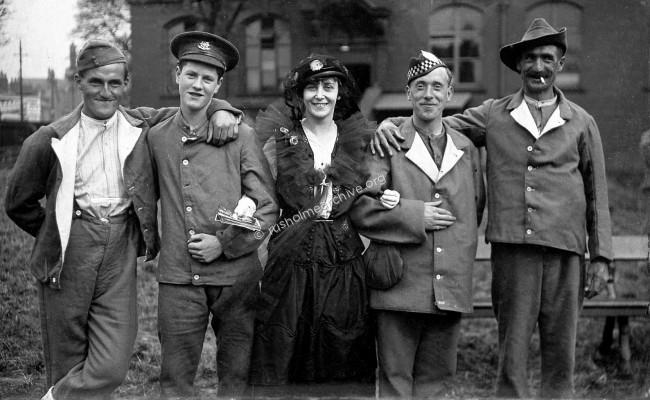
The visit of Lydia to the hospital (seen above with convalescing soldiers on her arms), was reported on September 25th in the Manchester Evening News;
Famous Russian dancer at Military Hospital: Miss Lydia Kyasht accompanied by George Reynolds manager of Manchester Hippodrome visited the High Street Hospital, and presented the soldiers, among whom were a number of New Zealanders who had just arrived from the Dardenelles, with gifts from the Russian people.
Lydia Kyasht (25 March 1885 — 11 January 1959) was a Russian-British ballerina and dance teacher. She was described by one critic as "the World's Most Beautiful Dancer" in 1914.
The photograph below was also taken some time during WW1, (1914-18). Soldiers recovering from their injuries were staying at Newbury, a Red Cross Hospital on Daisy Bank Road, Victoria Park. Here they are seen in a fairly relaxed mood having been entertained by the Birch Lane Members Club, (Longsight), where bowls and tennis was popular - see the soldiers holding racquets and bowls on the front row.
Read more about WW1 on the page 'Rusholme Military Hospitals'.
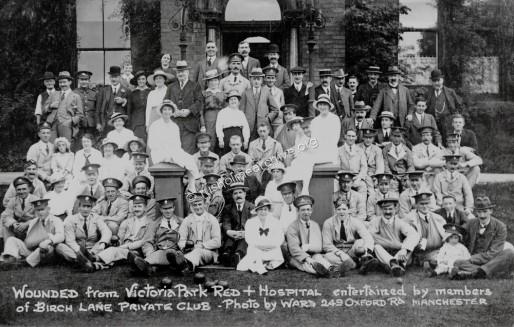
Postcard view below is of Platt Abbey circa 1905
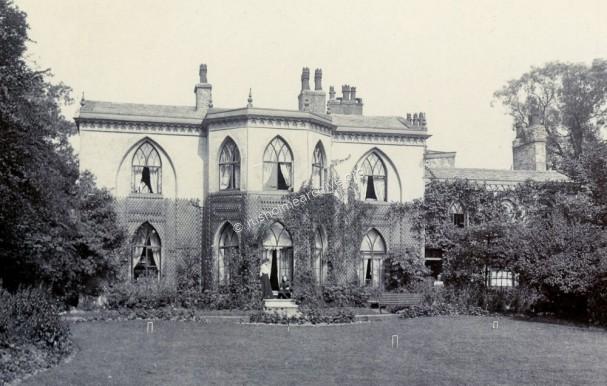
Platt Abbey was private residence built in the early 1800's on a plot of land bordered by Wilmslow Road and Norman Road. Author and playwright Ian Hay was born at Platt Abbey in 1876, the property becoming a hotel before being demolished in 1950 and replaced by two blocks of flats, Platt and Worsley Court.
You can read more about Ian Hay and Platt Abbey towards the end of the page, 'A Tour of Wilmslow Road'.
This website is about a history of Rusholme & Victoria Park.
You can search the website by entering a keyword in the search box at the top of each page
The archive has been compiled by a Rusholme resident who has been collecting old postcards, photos, books and other memorabilia which illustrate the ways in which the area has changed over the past 100 years.
Unlike the books that have been written about Rusholme & Fallowfield this website will be a continuing project and will not have a cut-off date when the book has to go to press.
Any new information about Rusholme & Victoria Park will always be welcome.
I hope that visitors to the website will be prepared to loan such items and you may have family members or friends who have memories of past events in Rusholme that I can also record & publish on this website.
Contact: admin@rusholmearchive.org
I have enjoyed the last 10 - 12 years researching and writing about the history of this area. During this time I have been asked to give talks, presentations etc. about the history of Rusholme.
Although I have usually been able to agree to these requests I have now decided, (albeit with some reluctance), that it can be too time consuming and would like to make it quite clear that in future any such requests will be politely declined.
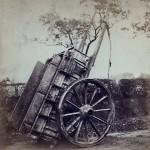 Rusholme is now considered an 'inner-city suburb' some 2+ miles south of Manchester, a city in the North-West of the UK. Rusholme is immediately south of the Manchester Universities and straddles the Wilmslow Road, now popularly known as 'Curry Mile'
Rusholme is now considered an 'inner-city suburb' some 2+ miles south of Manchester, a city in the North-West of the UK. Rusholme is immediately south of the Manchester Universities and straddles the Wilmslow Road, now popularly known as 'Curry Mile'
Up until the early part of the 19th century Rusholme was a village lying in the countryside to the south of Manchester & dominated by the two large estates of Birch, (owned by the Anson family), & the Platt Hall estate, (owned by the Worsley family). Click on the photo of the farm cart, this was taken circa 1865 by Helmut Petschler and clearly shows the name of Mary Broome, who according to the 1861 census was the farmer at Lower Oak Farm in Rusholme.
Thomas Lowe was a resident of Rusholme between 1836 and 1892; when he first arrived in Rusholme in 1836 the following is an account of the Rusholme that he knew as a young man.
"The Green was perhaps the most charming feature of the village. It extended from Dickenson Road to what is now Thurloe Street. A low stone bridge crossed the clear sparkling brook and "children coming home from school" leaned over the parapets to see the water rippling over its pebbly bed. This same bridge was the favourite resort of farm-labourers, hand-loom weavers, and others, who foregathered here to discuss politics, or perhaps the gossip of the village.
The chief excitement of the day was to see the stage coach pass on its way to or from Manchester; the pleasant jingle of its trappings, and the cheerful notes of its "echoing horn," drew the simple village folk, and especially the children, to watch this picturesque link uniting Manchester to the world beyond. A milder excitement was occasioned by the omnibus, which started from an old farm-house which stood a little way back from the road in what is now Victoria Park. This somewhat lumbering vehicle made several journeys to Manchester and back in the day, and carried passengers, if it could get them, at sixpence per head."
At the census of 1831 the township of Rusholme contained 179 houses and a population of 1,078. It was then emphatically a village, and depended chiefly upon its agriculture and its hand-loom weaving, which was carried on in most of its thatched cottages, the click of the shuttle being one of the most familiar sounds in the quiet rural life of those days.
Gradually as Manchester industrialized the simple village occupations of weaving, farming inevitably gave way to the earnings in the huge mills, engineering works & other chemical works which lured people away from the Village Green.
The 1873 Post Office Directory refers to the acreage of Rusholme as being 1480, (including Birch-in-Rusholme).
On page 3 of the website, 'Rusholme a century ago' there is more about the history of Rusholme.
A westerly view below looking to the junction of Dickenson Road and Wilmslow Road taken around the 1860’s by Helmut Petschler. Rusholme Public Hall and Library is the stone-faced building on the right and the cottage on Wilmslow Road is now the site of Charles Wilson Motors.
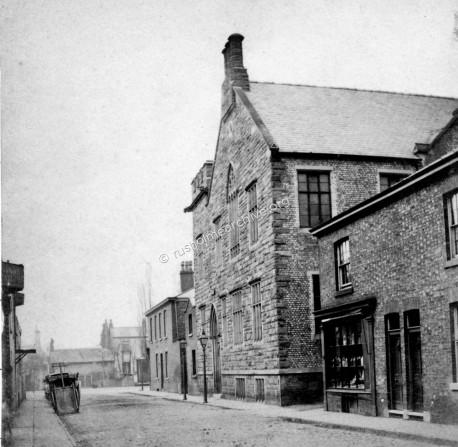
Rusholme, Wilmslow Rd looking north.
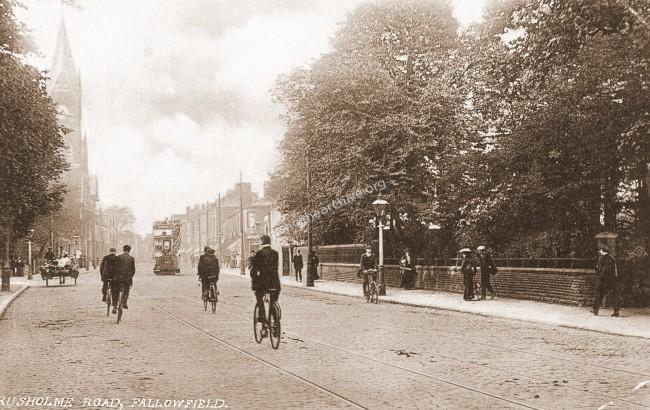
Rusholme, similar views from Finglands Garage 1909
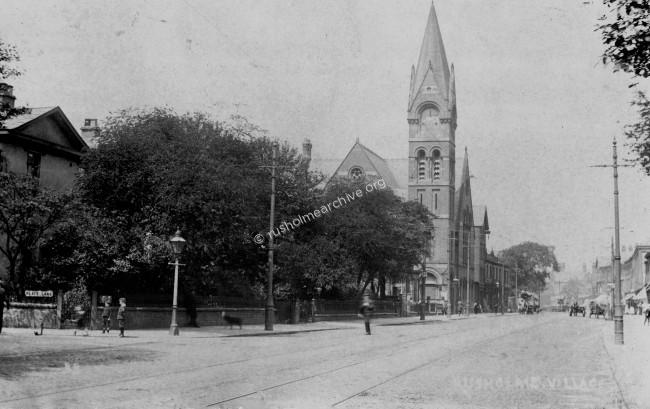
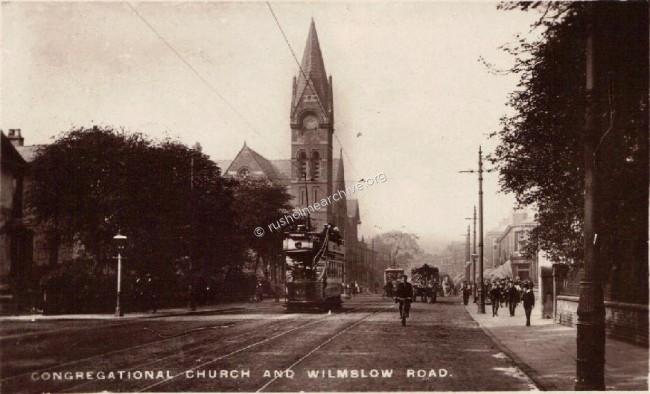
'Iconic' views' above of how this junction looked at the beginning of the 20th century. Platt Lane to the left, Dickenson Rd to the right in the photographs above. Birch Villa Inn, (Hardy's Well) on the right hand side, is still in business, having been on this site since the 1830's. The Congregational church, on the left by Alfred Waterhouse, now demolished but in 1909 the spire & clock was a notable landmark. In the top photograph the gardens of the houses on the right have been replaced by Finglands Garage.
Finglands: 'As supplied to Royalty'
The postcard is dated August 8th, 1913.
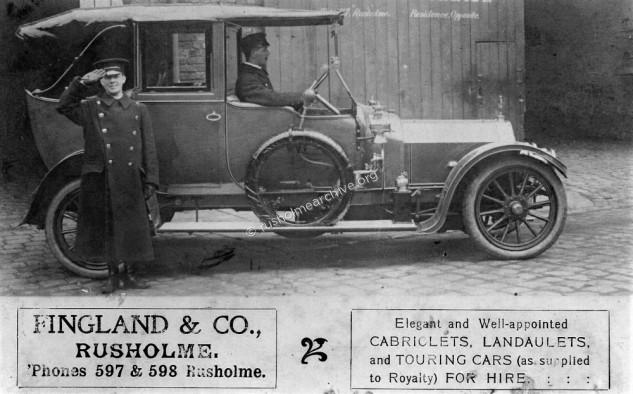
Finglands History
Charles Fingland worked for Rolls Royce as a test driver until 1907 when he started Finglands Hire Cars and Bookings. Originally running luxury limousines demand gave him the opportunity to expand into coach hire.
Scheduled coach services followed and Finglands became the first coach company to run a scheduled service between Manchester and London with a coach having an on board toilet and radio. Bookings were taken at the head office in Manchester and also at an office in Southampton Row in London.
Always a company with an eye on the future Finglands Airways took to the air in 1949 operating two Avro Ansons. The main use for these was an operation called "Combined Ops" where passengers were collected from their homes in Manchester taken to the airfield and transported by plane to Newquay. There a Finglands coach waited and would convey passengers to their hotel and provide outings during their stay. It also gave the opportunity to make excursions to see Blackpool Illuminations from the air! One of the pilots was Robert Fingland who had gained his experience with the Royal Air Force.
However, the cost of operating airplanes was substantial and Finglands Airways ceased operation in 1952. The Fingland's family decided to sell the business following this and a sale took place to Mr Robert Bunning, the General Manager in 1954.
The coach business was expanded and a number of local companies were acquired. C Holt Coaches, South Manchester Coachways, Corkhills Coaches and Fieldsends Coaches. Eventually the Finglands Group of companies comprised of Finglands Coachways Ltd, Finglands Travel Agency Ltd and Finglands Garage Ltd.
In 1992 Finglands was acquired by East Yorkshire Motor Services, but now in 2013 the bus operation has become part of the First Group and Finglands Coach company has been sold.
I sourced this photograph from a dealer in Idaho, USA. I wonder how the postcard arrived there? The photograph is undated, interestingly, it taken outside of 'West View', one of the houses in Upper Park Road, Victoria Park. I have also shown the text on the address side.
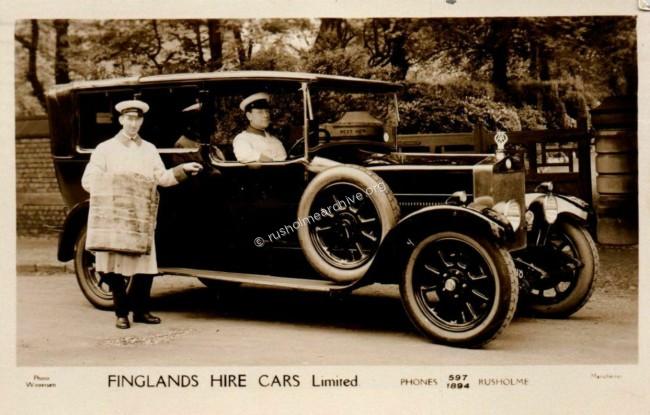
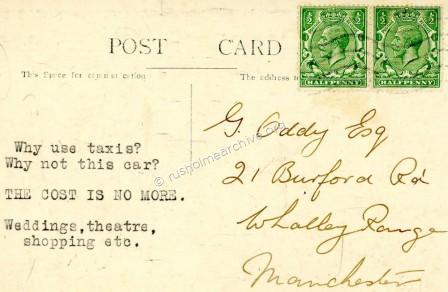
The photograph below is of a Finglands Hearse circa 1910
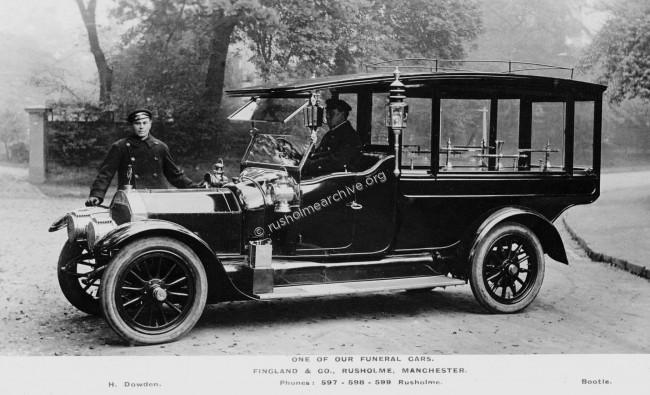
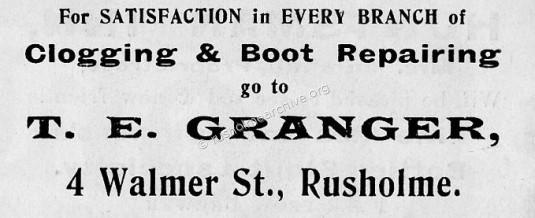
The photograph below was found by Joop Campfens, who lives in Holland. He found it amongst some family papers and searching the web for the photographer’s name, (on the back of the cdv) he came across rusholmearchive and has now kindly given it rusholmearchive.org. The inevitable question is how did that photograph, taken 150 years ago find its way to some family papers in Holland?
The photograph was taken circa 1860-65 by William Roberts, who William Royle described as the village photographer. Although the sitters are not identified the man centre right with the top hat may be William Ulph, a member of the Rusholme Board of Health. There will be more information on the page about Rusholme Photographers.
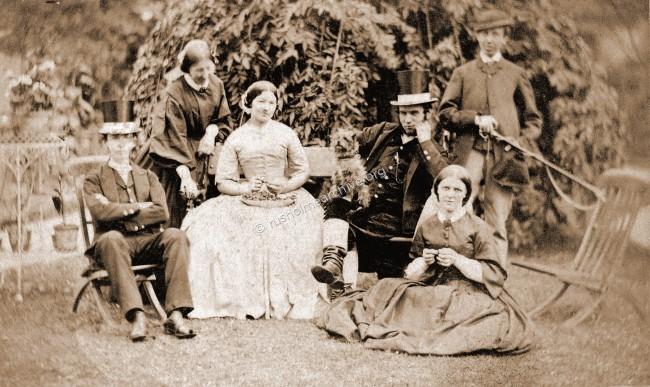
Tel. 123 Rusholme
John Jones, builder, Greenheys.In the photograph below the builders standing by their cart are looking a little surprised at the camera taking the photograph. They are certainly dressed for work - note the clogs they are wearing. Although Greenheys is just on the border of Rusholme the telephone number painted on the cart must be one of the earliest Rusholme Exchange numbers, 'Rusholme123'
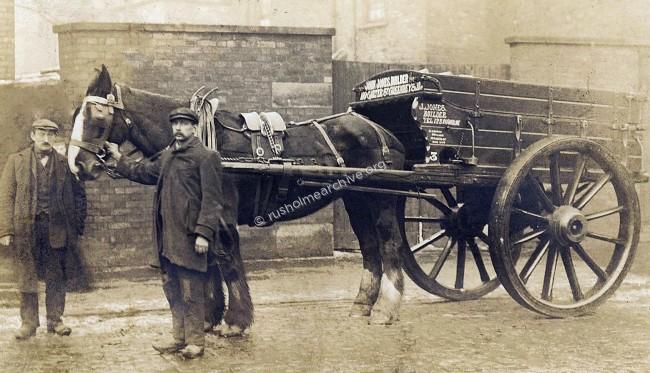
George William Price photographed below at the 'Birch Studio', 124 Dickenson Road circa 1910. Baptised at St James, Birch-in-Rusholme 16 Dec 1906 his father, Thomas Henry Price was an upholsterer living in Kathleen Grove with his wife Sarah Annie.
There was a prolific output of Rusholme family photographs by Frank Wyles at his Dickenson Road studio; see the page on Rusholme photographers.

Rusholme Toothpaste!
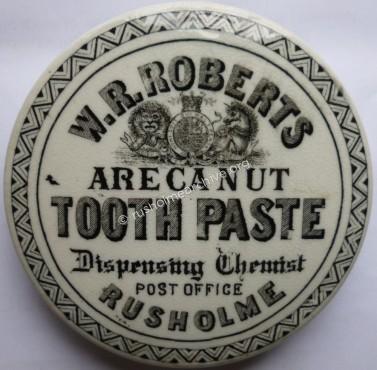
Rusholme ice cream?
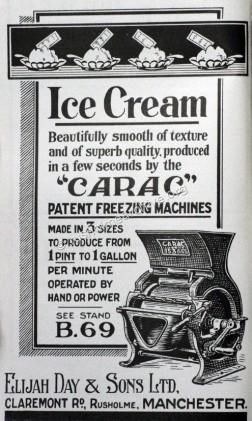
Old Rusholme! Boys playing in an unknown street 1906
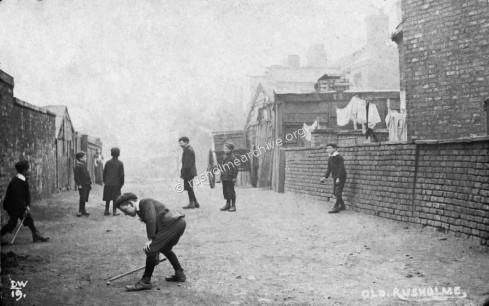
To emphasis the past rural nature of Rusholme the postcard below is dated 1904, the view is of Birch Hall Farm.
It was situated approximately at the north-east corner of the grounds of Manchester Grammar School and the farmhouse was demolished in 1926. Below the card I have reproduced the message on the back of the card - presumably the reference is to Birch School, further down the lane(?).
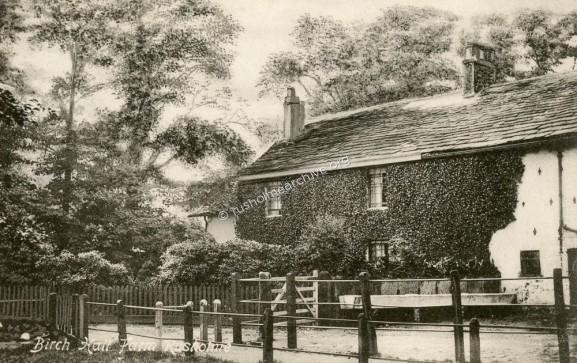
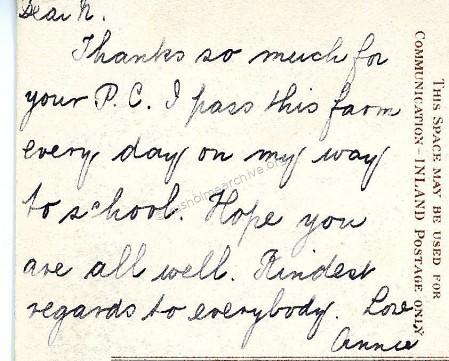
The watercolour below is of Birch Hall Farm and is dated 1877.
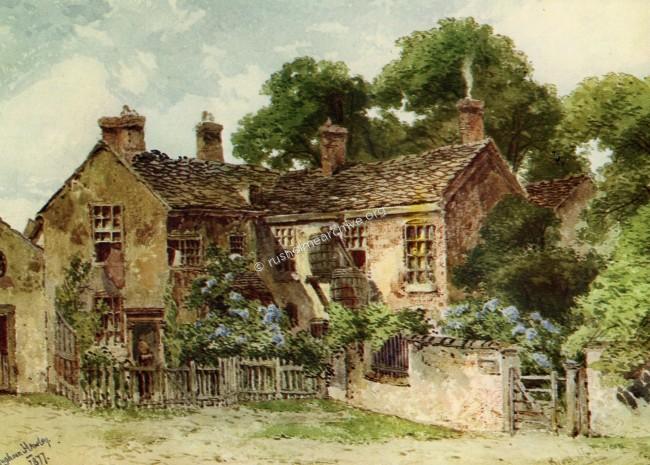
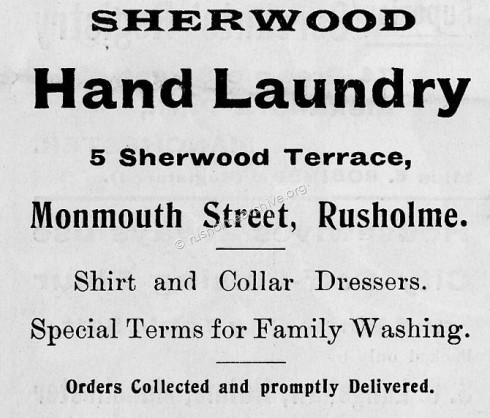
Dedicated to the memory of William Royle of Rusholme (1854-1923).
His love of Rusholme, foresight and energy over 100 years ago has ensured that Platt Fields continues to be an 'Important contribution to the beauty and health of the city'
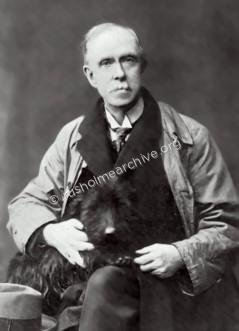
The obituary for William Royle was published in the Manchester Guardian, Wednesday 6th June 1923.
“BY the death of Mr. William Royle Manchester has lost one of her most devoted citizens and Rusholme a constant friend and benefactor. Mr. Royle carried into politics the same heartiness and disinterested zeal which he applied to his social and religious activities. He was ever a good party man, active and capable in all the machinery of politics, but his Liberalism had nothing mechanical about it; it rose out of the pure fount of a disinterested desire to serve the community and sustain the moral standard of the nation. His politics and his religion came pretty close together, and both were unselfish and served a common ideal. But with his idealism there went a powerful practical strain which gave him balance and effect. He was an excellent businessman and skilful organiser, and in this union of qualities he found and merited success. He set a fine example of the true civic life. In Rusholme he was born, and in Rusholme he was content to work and to live to the end of his days. To him it was no dismal region of congested houses or submerged gentilities. It was his home and his delight, and he brought to it the pride and the devotion of the citizen of no mean city. It was transfused by his ardour and made better in a thousand ways by his efforts. There was in its streets and homes no more familiar figure, none more beloved. It is a small thing to say that he will be sorely missed and deeply mourned. He lived a fine, even a heroic life, and his name will smell sweet for many a long day among the many who have known and loved him.
William Royle was born in his much beloved Rusholme in the year 1854. He came of a humble but very strictly living family, and his early years gave him a Puritan cast of mind and life which he never lost. In the middle and later periods of life public affairs carried him much into the atmosphere of clubs, and few men could enter with more zest and enjoyment into the joyful and festive side of party or settle down more contentedly for a good gossip about all that was going on behind the scenes of politics. But though he thoroughly enjoyed Rome he never quite did as the Romans do. No one could warm more genially to the walnuts-and-wine moods and moments of life, but for him at any rate there must be no wine. He was the most clubable of men, but he did not even smoke. It is practically certain that he disapproved of the theatre. He looked very much like a Cromwellian, but no friend of William Royle could see anything of William Royle except the light that seemed to be permanently settled on his forehead and the upper part of his face, and it was this light which modulated him from the Cromwellian into the Christian citizen.
William Royle went into the Manchester trade when he was quite a boy and had been for many years in the service of the firm of N. P. Nathan’s Sons in Lower Mosley Street. Early in life he was threatened with a serious lung trouble, and he lived for six months in the Canary Islands returning to Manchester, as his subsequent career shows, effectually cured. He rose to a high position in the firm with which he was connected, and eventually towards the close of his life became a partner. In his own branch of the Manchester trade he was a considerable expert. Very often he acted as one of the arbitrators whom the Chamber of Commerce supplies to settle disputes between Manchester merchants, and it was a cause of some pride with him that so few of his decisions were ever challenged by an appeal to the law courts.
His active connection with the Liberal party began many years ago. Mr. William Simpson, who had much to do with the beginnings of the Manchester Liberal Federation, discovered William Royle’s value as a party manager, and started him along the course which led ultimately to his becoming chairman of the Executive Committee of the Federation, an office which he held until the close of his life. It was what might be called the “ key ” office of the Federation, and from it William Royle exercised great influence over the affairs of the Liberal party in Manchester, acting as friend and “ father” to all Liberal candidates for the divisions of Manchester, not excluding, as they would themselves be among the first to admit, Mr. Winston Churchill and Sir Gordon Hewart. During this long period no great Liberal meeting in Manchester would have been complete without him. Except at small divisional meetings he did not himself speak, and even at these chiefly for the purpose of encouraging organisation. But no one who went much to the Free Trade Hall on the great party occasions which came to an end with the war, will forget William Royle in his place in the front row of the platform, the tension of his figure, his “ Hear, hears,” which were more frequent than the “ Hear, hears ” of anyone else, and were some-times a solitary ejaculation, and the visible effort he was personally making to spread rapport between the speaker of the night and the audience. For a man who was singularly incapable of hurting a fly he had a fierce and sometimes it seemed an almost truculent joy in the hard knocks of party fighting. He got nothing out of his many years of Liberal work except the satisfaction of serving the cause and a lot of enjoyable fellowship. Twice at least he refused a knighthood, and though he had so much to do with recommending appointments to the bench he was not a magistrate himself. He would probably have liked very much to stand for Parliament, but it was not his fortune.
William Royle was a Manchester patriot, and inside his love for Manchester there was wrapped a still more intimate love for Rusholme. It was owing to his prompt exertions that the ninety acres of Platt Fields were saved from the builder and secured to the use of the city as a public park. This was his great achievement in local citizenship.
At one time he had a habit of giving a lecture not less to his own enjoyment than that of his audience, on “ Bygone Rusholme,” and eventually he expanded the lecture into a book which he called the “ History of Rusholme,” and which may be read with pleasure for the glimpses it gives into the past, both near and remote, of a very old settlement of population. His service to the poorer people of Rusholme was incessant and was carried on without the least regard for his own comfort or convenience. It might be said that not a sparrow could fall to the ground in Rusholme, but he knew of it. He was a familiar figure in all the poor streets of the district. There were times when he might have been seen in the small hours of morning fetching a district nurse to some case of illness to which he had himself been called out of his bed, and a friend who once sat with him throughout the whole of a Saturday after-noon and evening counted precisely thirty rings at his bell during that period, most of which brought demands on him for money or for trouble and time.
His busiest day was Sunday. William Royle was a Wesleyan. He was the life and soul of the McLaren Memorial Institute in Rusholme. Some years ago, he suffered a blow which his friends feared would overcome his spirit. His only son, a very promising boy, was killed in the war, and almost at the same time he lost his wife. It was in these circumstances that the work which he was always doing for others came to his own rescue and, being continued without a moment’s cessation, saved the structure of his life."
